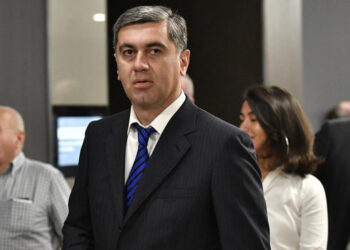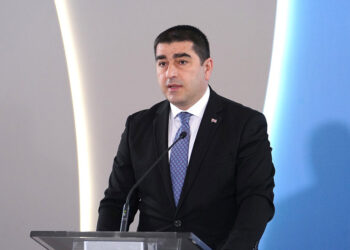The Kremlin has once again dismissed the idea of NATO troops being deployed in Ukraine as part of any peace settlement, even as fighting intensifies along the frontline.
During its daily briefing, Kremlin spokesperson Dmitry Peskov acknowledged that US efforts to broker peace in Ukraine are “very important” and could help resolve the protracted conflict. However, he criticized European proposals for security guarantees for Ukraine, emphasizing Moscow’s longstanding position that no NATO forces should be stationed in the country.
Peskov added that any high-level peace talks with Kyiv would need thorough preparation to be effective. Responding to reports of recent strikes on Ukraine’s energy infrastructure, he reiterated that Russian forces only target military and military-connected sites.
Meanwhile, preparations are underway for Russian President Vladimir Putin’s upcoming trip to China, which Peskov described as “unprecedented.” Putin will attend the Shanghai Cooperation Organization (SCO) summit in Tianjin from August 31 to September 1, alongside more than 20 world leaders, before visiting Vladivostok on September 5.
Ukraine confirmed that Russian troops have crossed into the eastern Dnipropetrovsk region, attempting to establish a foothold. Kyiv, however, denied reports that Russia has captured two villages. Moscow has repeatedly claimed entry into the area over the past three months as part of its push from Donetsk.
Battlefield analysts from DeepState reported that Russia occupies two villages—Zaporizke and Novohryhorivka—marking the first claimed advances into Dnipropetrovsk. Ukraine’s armed forces general staff, however, countered that Zaporizke remains under Ukrainian control, while “active hostilities” continue near Novohryhorivka. Russia’s defense ministry released images it claims show troops inside Zaporizke.
Unlike Luhansk, Donetsk, Zaporizhzhia, Kherson, and Crimea, which Russia has annexed, Moscow has not claimed Dnipropetrovsk. Reports suggest that Putin seeks control of the Donetsk and Luhansk regions—the Donbas—as a precondition for ending the war. Any further Russian advances into Dnipropetrovsk could strengthen Moscow’s negotiating position in future peace talks.
Ukraine’s air force reported downing 74 of 95 drones launched by Russia this week, with 21 drones striking nine locations. Two civilians were killed in Donetsk, and 12 others were injured. A mass drone attack on Sumy disrupted electricity and water services, while Poltava experienced power outages after Russian strikes on an energy facility. Additional attacks injured civilians in Kharkiv, Zaporizhzhia, and Kherson, affecting 36 settlements including the regional center.
Attacks on energy infrastructure, historically concentrated in winter months, are increasingly occurring in summer. Ukraine’s energy ministry reported over 2,900 attacks since March 2025 alone. Ukrainian strikes on Russian oil refineries have disrupted at least 17% of Russia’s refining capacity, halting operations at facilities in Volgograd, Samara, Saratov, and other regions. Long-range drone strikes have become a central element of Kyiv’s strategy to weaken Russia’s war economy.
In the Donetsk region, Ukrainian forces have successfully countered a Russian penetration east and northeast of Dobropillya. Reports indicate that Ukrainian troops have seized key settlements such as Nove Shakhove and Zapovidne, pushing Russian forces back from strategic positions along the Dobropillya-Kramatorsk highway. These actions threaten to encircle elements of the Russian 51st Combined Arms Army operating within the penetration.
Russian military command has reportedly ceased efforts to exploit the penetration towards Dobropillya, indicating a shift in their operational focus.
Ukrainian partisan groups continue to disrupt Russian logistics and military operations in occupied territories. Recent actions include the ambush of a Russian supply convoy in Kalynove, Luhansk Oblast, resulting in casualties among Russian soldiers. Additionally, a railway control cabinet was blown up near occupied Melitopol, Zaporizhzhia Oblast, further hindering Russian supply lines.
US President Donald Trump commented on the conflict during a White House cabinet meeting. He stressed that economic sanctions could be imposed on Russia if a ceasefire is not agreed, while cautioning that both sides share responsibility for the ongoing war. Trump highlighted his relationship with Putin, claiming he has the influence to help resolve the crisis and emphasizing the human toll, with “thousands of young people dying every week.”
After a summer marked by tense diplomacy and stark strategic realities, it is increasingly clear that Europe is largely on its own in defending Ukraine—and by extension, its own security—against Russian aggression, as US support under Trump becomes minimal, unreliable, and transactional. Despite a show of unity with President Zelensky in Washington, European leaders were forced to accept an unbalanced trade deal and make sweeping defence pledges to appease Trump, who has refused NATO membership for Ukraine, downplayed sanctions on Russia, and offered only vague, limited backing for a European-led reassurance force. With US intelligence-sharing curtailed and no guarantee of American military support, Europe faces the daunting challenge of organizing and sustaining a credible security commitment to Ukraine amid internal political divisions, strategic doubts, and memories of past peacekeeping failures—raising urgent questions about whether the EU can deter Russia without dependable US backing.
Compiled by Ana Dumbadze














